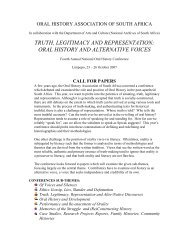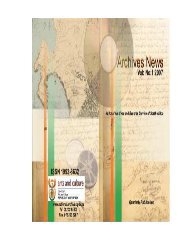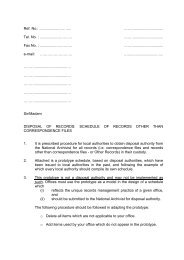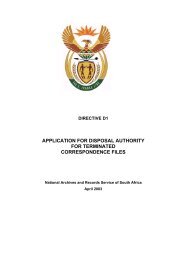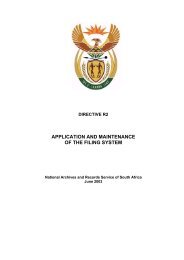managing electronic records in governmental bodies - National ...
managing electronic records in governmental bodies - National ...
managing electronic records in governmental bodies - National ...
Create successful ePaper yourself
Turn your PDF publications into a flip-book with our unique Google optimized e-Paper software.
25<br />
• if and e-mail is received and no reply is necessary, pr<strong>in</strong>t and file the message;<br />
• if an e-mail message is sent and a reply is expected, keep the e-mail until the<br />
matter is f<strong>in</strong>alised. As soon as the matter is f<strong>in</strong>alised, pr<strong>in</strong>t all related messages<br />
and file them. A good option would be to require the recipient to always attach<br />
the orig<strong>in</strong>al message text to the replies. In this way all messages sent and<br />
received on the same matter are kept together;<br />
• if an e-mail is received and a reply is expected, keep the e-mail until the matter is<br />
f<strong>in</strong>alised. As soon as the matter is f<strong>in</strong>alised pr<strong>in</strong>t and file the message. A good<br />
option would be to reply to the message and to attach the orig<strong>in</strong>al message text<br />
to the replies. In this way all messages sent and received on the same matter are<br />
kept together;<br />
• if a message is sent to a distribution list and the recipients reply to the message,<br />
different <strong>records</strong> are generated, that should each be kept until the <strong>in</strong>dividual<br />
matters are f<strong>in</strong>alised and then be pr<strong>in</strong>ted and filed separately.<br />
If the second option is used, the above approached to prevent duplication could also<br />
apply for messages saved <strong>in</strong>to the <strong>electronic</strong> repository, depend<strong>in</strong>g on the specific<br />
features of the Integrated Document Management System and the bus<strong>in</strong>ess rules of<br />
the particular office.<br />
Whichever method is chosen, all users should be aware of the policies, procedures,<br />
and tools for <strong>manag<strong>in</strong>g</strong> e-mail messages and they should be capable of apply<strong>in</strong>g<br />
them consistently to all <strong>records</strong>. Furthermore, both the paper-based and the<br />
<strong>electronic</strong> <strong>records</strong> management system must ensure that:<br />
• related <strong>records</strong> are grouped together <strong>in</strong> accordance with the office’s file plan;<br />
• the <strong>records</strong> are accessible to authorised persons;<br />
• the retention of the <strong>records</strong> is supported for as long as they are required;<br />
• destruction of <strong>records</strong> can take place when so scheduled; and<br />
• permanent preservation of archival valuable <strong>records</strong> is supported.<br />
When preserv<strong>in</strong>g <strong>electronic</strong> messages, the follow<strong>in</strong>g specific requirements should<br />
also be kept <strong>in</strong> m<strong>in</strong>d:<br />
• The e-mail message must <strong>in</strong>clude transmission data as well as the message<br />
itself and all the attachments to the message. The transmission data identifies<br />
the sender and the recipient(s) and the date and time the message was sent<br />
and/or received. This data provides essential context for the message. This is<br />
equivalent to correspondence on paper, where the record <strong>in</strong>cludes<br />
<strong>in</strong>formation identify<strong>in</strong>g the sender and recipient and the date of the letter, not<br />
just the message. Any attachments conta<strong>in</strong><strong>in</strong>g <strong>in</strong>formation necessary for<br />
decision-mak<strong>in</strong>g or to understand the <strong>in</strong>tention or the context of a message<br />
should also be kept as part of the record.<br />
• When e-mail is sent to a distribution list, <strong>in</strong>formation identify<strong>in</strong>g all parties on<br />
the list must be reta<strong>in</strong>ed for as long as the message is reta<strong>in</strong>ed.<br />
• If the e-mail system uses codes, aliases, nicknames, or anyth<strong>in</strong>g other than<br />
the real name of senders or recipients, their real identities need to be reta<strong>in</strong>ed<br />
as part of the record.<br />
• if a message is sent to a distribution list and the recipients reply to the<br />
message, different <strong>records</strong> are generated that should be filed as separate<br />
Manag<strong>in</strong>g <strong>electronic</strong> <strong>records</strong>_Policy Guidel<strong>in</strong>es.doc<br />
First Edition<br />
Version 1.1<br />
April 2003








